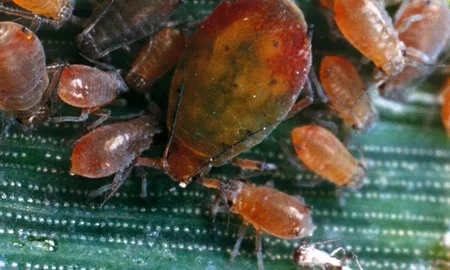
Find out how to avoid common pitfalls when identifying aphids, to inform the timing of your sprays – and ensure you don’t spray unnecessarily.
Author
| 5th October 2018Aphid identification: 7 top tips
1. Always identify adults
Nymphs go through several stages and are far harder to tell apart than their adult counterparts. Most adult aphids are 1-4mm long and come in both winged and wingless forms. Mature aphids will have a clearly defined cauda (tail) or wings and will often be surrounded by tiny nymphs.
2. Use a hand lens
The optical lens in a hand-held lens can be glass or plastic – plastic lenses are cheaper and lighter but are of lower quality and harder to keep clean. A 10x magnification should be sufficient to let you see colours and details of an aphid, allowing accurate identification.
3. Know what to look for
Accurate identification requires careful examination of up to six common distinguishing features:
Shape of head and antennal tubercules (bumps on the head that house the base of the antennae)
Antennae length compared with body length
Shape, size and colour of the siphunculi (short cylindrical structures at the cauda end of the abdomen)
Abdominal markings
Cauda (tail) length compared with siphunculi length
Wing vein shade
Check out the diagram to see the characteristics of these features on the aphid you are trying to identify.


For help with identifying the three aphids that carry barley yellow dwarf virus, click here.
4. Don’t be fooled by colour
Unlike mammals, birds and reptiles, some species of aphid can encompass a huge range of colour variation between individuals – even within one field. For example, the peach-potato aphid usually has a green body, but pink-bodied individuals are also frequently seen. Other peach-potato individuals have been identified that are almost white, red or almost black. At the other end of the scale, the black bean aphid is always reassuringly black.
5. Host plant will provide clues – but can be misleading
The host plant will help narrow down potential species, but it is not definitive.
Winged aphids are weak flyers and are largely dependent on air currents to carry them to their summer host crops. Although they can travel long distances in this way – sometimes hundreds of miles – they don’t always have total control over where they land. Consequently, they often land on non-host plants initially, before moving on.
While these aphids may not feed on the non-host crop, some can be significant virus vectors, so keep an open mind when identifying aphids and don’t guess its identity based purely on the crop you have found it in. Also consider that some might be colonisers of that crop, some non-colonisers that can infect it with a virus, and some non-colonisers that won’t have any effect at all.
6. Consider climate and weather conditions
Weather, as well as species, will influence whether aphids overwinter as eggs or wingless individuals. In the south of the UK, where winters are warmer, fewer aphids produce a sexual generation and more will remain in the wingless asexual form. Weather can also affect migration – very wet or windy weather tends to halt aphid flight. If these conditions occur during spring, migration will be delayed.
7. Keep up with AHDB aphid monitoring in your area
AHDB’s weekly news bulletins will let you know which aphids have been found on cereals and oilseed rape in relevant parts of the UK. AHDB also produces forecasts each March predicting when aphid migration and reproduction will take place.